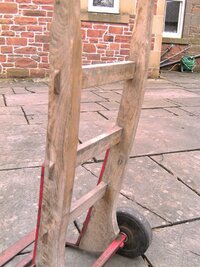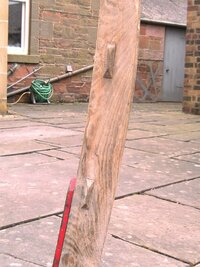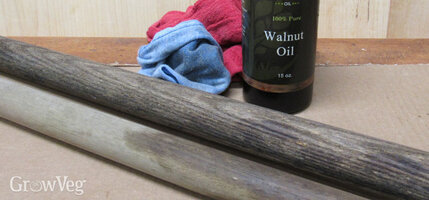This is why I haven't finished restoring the Max Sievert blow torch yet. Oh, plus the fact it's been too bloody cold to spend much time in an unheated garage. Plus the fact I have a lot of demands on me time apart from motorbikes and old brass blow torches. However this is today's excuse, not of course that I need one.
In November, the couple who lived opposite, good friends, moved house. Was helping with packing & moving stuff and remarked on this old porter's trolley. Richard corrected me, not a porter's trolley but a sack barrow and you're welcome to have it. Absolutely insisted, don't you know.
Today, pulled it out into the light. Nothing much wrong with it. I'm calling it a vintage barrow because I have no idea when it was made. These days, they make barrows with spray-painted metal tubes and plastic wheels but this old feller has hardwood handles and a heavy, solid-looking, cast or forged (?) lifting platform, secured to the wooden frame by heavy through-bolts. So I reckon it must have been made a good while ago.
The wheels, solid and heavy like the rest, not sure the material, might be some type of vulcanised or synthetic rubber run on solid steel axles but all rusted up and dry. One washer missing - there should be four - and one split-pin missing. Mind you, full credit to the person who not only replaced the split-pin with a long thin nail but went the extra mile by bending the nail with 3 right angles to make sure it won't fall out.
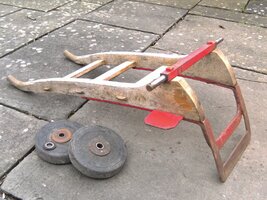
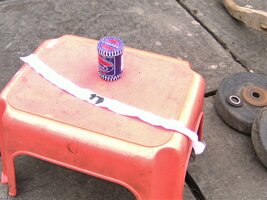
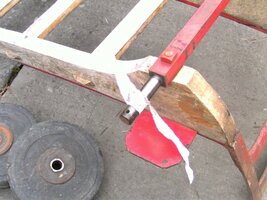
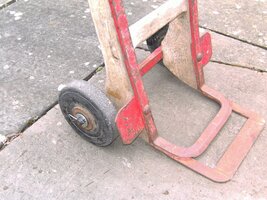
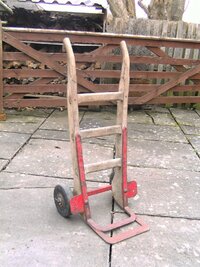
Today's job turned out to be getting the wheels off, cleaning the rusty axles, and shoving the wheels back on with four new washers, two new split-pins and plenty of moly grease.* As you might see, had a bright (sorry) idea for cleaning the axles with a dab of grinding paste on a strip of rag, passed once round the axle and pulled to-and-fro to remove the rust. Actually began a debate with myself, should I use from the Fine or the Coarse end of the grinding paste? Would coarse be too aggressive? Would fine take too long to shift the corrosion? The debate lasted about half-a-second and the argument what won it was the thought, 'this is a sack barrow ferchrissakes, not a performance camshaft.'
I think that is quite a handsome barrow. Deserves cleaning the woodwork, maybe lightly sand and apply some oil or wax. Might even paint the metal platform. Not much idea what I'll use it for. Occasionally need to shift slices of tree trunk for wood-splitting - they're too heavy to carry far and awkward to balance on a wheelbarrow. But I'll probably keep it even if it doesn't have a job.
* Went to Falla in Bonchester Bridge for the washers and pins. Nice run up into the hills on the W800.
In November, the couple who lived opposite, good friends, moved house. Was helping with packing & moving stuff and remarked on this old porter's trolley. Richard corrected me, not a porter's trolley but a sack barrow and you're welcome to have it. Absolutely insisted, don't you know.
Today, pulled it out into the light. Nothing much wrong with it. I'm calling it a vintage barrow because I have no idea when it was made. These days, they make barrows with spray-painted metal tubes and plastic wheels but this old feller has hardwood handles and a heavy, solid-looking, cast or forged (?) lifting platform, secured to the wooden frame by heavy through-bolts. So I reckon it must have been made a good while ago.
The wheels, solid and heavy like the rest, not sure the material, might be some type of vulcanised or synthetic rubber run on solid steel axles but all rusted up and dry. One washer missing - there should be four - and one split-pin missing. Mind you, full credit to the person who not only replaced the split-pin with a long thin nail but went the extra mile by bending the nail with 3 right angles to make sure it won't fall out.





Today's job turned out to be getting the wheels off, cleaning the rusty axles, and shoving the wheels back on with four new washers, two new split-pins and plenty of moly grease.* As you might see, had a bright (sorry) idea for cleaning the axles with a dab of grinding paste on a strip of rag, passed once round the axle and pulled to-and-fro to remove the rust. Actually began a debate with myself, should I use from the Fine or the Coarse end of the grinding paste? Would coarse be too aggressive? Would fine take too long to shift the corrosion? The debate lasted about half-a-second and the argument what won it was the thought, 'this is a sack barrow ferchrissakes, not a performance camshaft.'
I think that is quite a handsome barrow. Deserves cleaning the woodwork, maybe lightly sand and apply some oil or wax. Might even paint the metal platform. Not much idea what I'll use it for. Occasionally need to shift slices of tree trunk for wood-splitting - they're too heavy to carry far and awkward to balance on a wheelbarrow. But I'll probably keep it even if it doesn't have a job.
* Went to Falla in Bonchester Bridge for the washers and pins. Nice run up into the hills on the W800.
Last edited:


